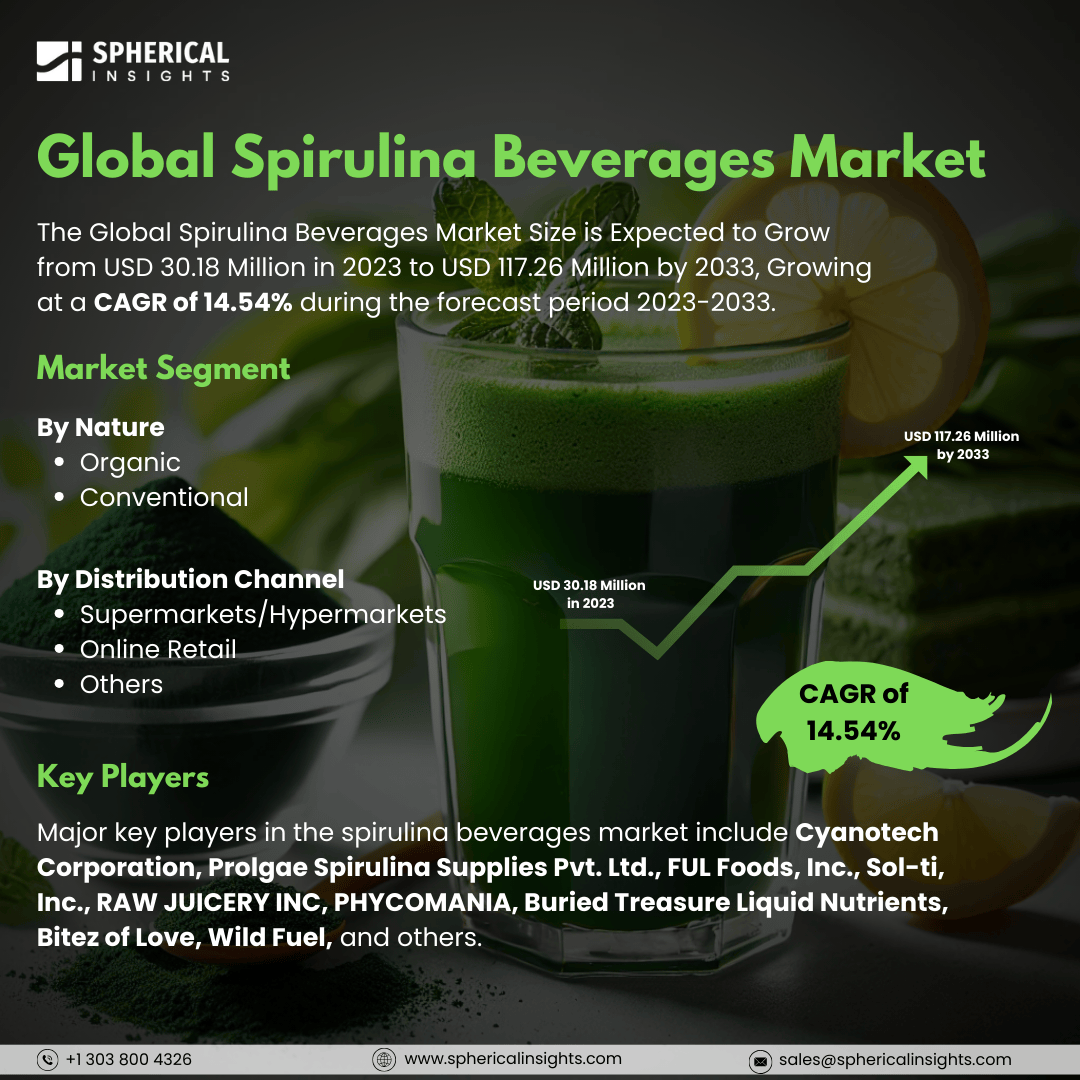Global Spirulina Beverages Market Size to Worth USD 117.26 Million by 2033
According to a research report published by Spherical Insights & Consulting, The Global Spirulina Beverages Market Size is Expected to Grow from USD 30.18 Million in 2023 to USD 117.26 Million by 2033, Growing at a CAGR of 14.54% during the forecast period 2023-2033.
Browse key industry insights spread across 215 pages with 110 Market data tables and figures & charts from the report on the Global Spirulina Beverages Market Size, Share, and COVID-19 Impact Analysis, By Nature (Organic and Conventional), By Distribution Channel (Supermarkets/ Hypermarkets, Online Retail, and Others), and By Region (North America, Europe, Asia-Pacific, Latin America, Middle East, and Africa), Analysis and Forecast 2023 – 2033.
Spirulina beverages are those that have spirulina as a main ingredient. A naturally occurring, nutrient-dense algae, spirulina is prized for its high protein, vitamin, mineral, and antioxidant content. The market's growth is mostly driven by trends such as veganism, the increasing number of people who are inclined to choose healthier dietary products, and substitutes for traditional meat protein. In the upcoming years, it is anticipated that growing customer tastes, efficient distribution tactics used by several market players, and improved product information accessibility will create more growth prospects. The growing demand for this market is being increased by the huge number of urban customers looking for quick, nutrient-rich, healthful food and beverages. The demand for spirulina is also significantly increasing as a result of its increasing popularity as one of the superfoods. Furthermore, the growing amount of information about the harmful consequences of chemicals used in ready-to-drink products has encouraged many consumers to switch to healthier product categories, such as spirulina drinks. However, insufficient knowledge about spirulina which is hindered the spirulina beverage market.
The organic segment is anticipated to hold a significant market share of the global spirulina beverages market through the forecast period.
Based on its nature, the spirulina beverages market is categorized into organic and conventional. Among these, the organic segment is anticipated to hold a significant market share of the global spirulina beverages market through the forecast period. This expansion is driven by rising consumer preference for healthier, chemical-free products. Spirulina, known for its high nutrient content and health benefits, is becoming a popular choice among health-conscious consumers.
The supermarkets/hypermarkets segment is predicted to hold the highest market share in the global spirulina beverages market over the projected timeframe.
Based on the distribution channel, the spirulina beverages market is classified into supermarkets/ hypermarkets, online retail, and others. Among these, the supermarkets/hypermarkets segment is predicted to hold the highest market share in the global spirulina beverages market over the projected timeframe. Supermarkets and hypermarkets in major cities of industrialized nations are contributing to the increase by providing a variety of consumer goods products, including processed foods, ready-to-make and ready-to-drink beverages, frozen meals, and several superfood options. The growth of this business is also being aided by supermarkets in emerging nations such as India that have exclusive food floors.
North America is estimated to hold the largest share of the spirulina beverages market through the forecast period.
North America is estimated to hold the largest share of the spirulina beverages market through the forecast period. Increasing availability made possible by online shopping portals and companies' increased emphasis on providing plant-based protein substitutes for meat proteins are the main reasons driving this market. The market's expansion is further aided by the availability of additional spirulina products, including pills, powder, and frozen goods. The desire of customers to include superfoods in their daily meals is driving this market. The trend is growing because so many individuals are adopting it.
Europe is predicted to grow at the fastest CAGR of the spirulina beverages market over the forecast period. Growing awareness of the nutritional value of superfoods, the growing demand for plant-based protein-rich goods, and the expansion of availability through supermarkets and hypermarkets are the main factors driving this industry. Growing customer desire for meat protein substitutes, improved accessibility facilitated by internet portals and e-commerce, and rising consumer awareness of the product's advantages are among the factors projected to drive this market's demand.
Company Profiling
Major key players in the spirulina beverages market include Cyanotech Corporation, Prolgae Spirulina Supplies Pvt. Ltd., FUL Foods, Inc., Sol-ti, Inc., RAW JUICERY INC, PHYCOMANIA, Buried Treasure Liquid Nutrients, Bitez of Love, Wild Fuel, and others.
Recent Developments
- In December 2024, the Juicy Group launched a new line of high-protein spirulina shakes featuring flavors such as mango spirulina, banana vanilla, and strawberry.
Key Target Audience
- Market Players
- Investors
- End-users
- Government Authorities
- Consulting And Research Firm
- Venture capitalists
- Value-Added Resellers (VARs)
Market Segment
This study forecasts revenue at global, regional, and country levels from 2023 to 2033. Spherical Insights has segmented the spirulina beverages market based on the below-mentioned segments:
Global Spirulina Beverages Market, By Nature
Global Spirulina Beverages Market, By Distribution Channel
- Supermarkets/Hypermarkets
- Online Retail
- Others
Global Spirulina Beverages Market, By Regional Analysis
- North America
- Europe
- Germany
- UK
- France
- Italy
- Spain
- Russia
- Rest of Europe
- Asia Pacific
- China
- Japan
- India
- South Korea
- Australia
- Rest of Asia Pacific
- South America
- Brazil
- Argentina
- Rest of South America
- Middle East & Africa
- UAE
- Saudi Arabia
- Qatar
- South Africa
- Rest of the Middle East & Africa



